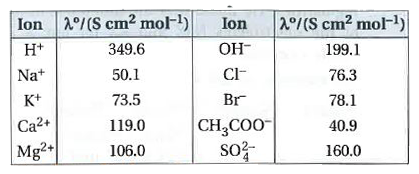Explain Kohlrausch law of independent migration of ions.
* Law: The law states that limiting molar conductivity of an electrolyte can be represented as the sum of the individual contributions of the anion and cation of the electrolyte.
* For example, if limiting molar conductivity of positive and negative ions is λ∘m+andλ∘m−, respectively then limiting molar conductivity of solution (λ∘m) will be as follows:
Λ∘m=v+λ∘m++v−λ∘m−
* Explanation:
If K+ of λ∘m+=73.5 and
λ∘m− of Br−=78.1 S cm2mol−1 then limiting molar conductivity of KBr solution at infinite dilution is as follows.
Λ∘m(KBr)=λ∘m(K+)+λ∘m(Br−)
=73.5+78.1
=151.6 S cm2mol−1

Topper's Solved these Questions
- ELECTROCHEMISTRYBOOK - KUMAR PRAKASHANCHAPTER - ELECTROCHEMISTRYEXERCISE - SECTION-A (Try Yourself)
25 Videos
- ELECTROCHEMISTRYBOOK - KUMAR PRAKASHANCHAPTER - ELECTROCHEMISTRYEXERCISE - SECTION-A (Practice Questions)
3 Videos
- ELECTROCHEMISTRYBOOK - KUMAR PRAKASHANCHAPTER - ELECTROCHEMISTRYEXERCISE - SECTION-E MCQ.s Asked in GUJCET/Board Exam
55 Videos
- CHEMISTRY IN EVERYDAY LIFEBOOK - KUMAR PRAKASHANCHAPTER - CHEMISTRY IN EVERYDAY LIFEEXERCISE - SECTION - E (MCQs ASKED IN GUJCET/BOARD EXAM)
37 Videos
- GENERAL PRINCIPLES AND PROCESSES OF ISOLATION OF ELEMENTSBOOK - KUMAR PRAKASHANCHAPTER - GENERAL PRINCIPLES AND PROCESSES OF ISOLATION OF ELEMENTSEXERCISE - SECTION - E (MCQs ASKED IN GUJET/BOARD EXAMS)
46 Videos
Similar Questions
Knowledge Check
Assertion: If λoNa+λoCl− are molar limiting conductivity of the sodium and chloride ions respectively, then the limiting molar conductivity for sodium chloride is given by the equation: ∧oNaCl=λoNa++λoCl−.
Reason: This is according to Kohlrausch law of independent migration of ions.Aif both assertion and reason are true and the reason is the correct explanation of the assertion.BIf both assertion and reason are true but reason is not the correct explanation of the assertion.CIf assertion is true but reason is falseDIf the assertion and reason both are false.
State Kohlrausch law of independent migration of ions. Derive the relationship between Gibbs energy of cell reaction and cell potential.
View SolutionState Kohlrausch law of independent migration of ions. Why does the conductivity of a solution decrease with dilution ?
View SolutionDefine the following terms :
(i) Molar conductivity (∧m)
(ii) Secondary batteries
(iii) Fuel cell
(b) State the following laws :
(i) Faraday first law of electrolysis
(ii) Kohlrausch's law of independent migration of ions.
View SolutionDefine the following terms :
(i) Molar conductivity (∧m)
(ii) Secondary batteries
(iii) Fuel cell
(b) State the following laws :
(i) Faraday first law of electrolysis
(ii) Kohlrausch's law of independent migration of ions.
View Solution(a) State Kohlrausch law of independent migration of ions. Write an expression for the molar conductivity of acetic acid at infinite dilution according to Kohlrausch law.
(b) Calculate Λ∘m , for acetic acid.
Given that Λ∘m(HCl)=426Scm2mol−1
Λ∘m(NaCl)=126Scm2mol−1
Λ∘m(CH3COONa)=91Scm2mol−1
View SolutionState Kohlrausch law of independent migration of ions. Write an expression for the molar conductivity of acetic acid at infinite dilution according to Kohlrausch law.
(b)Calculate:∧∘m for acetic acid.Given that:∧∘m(HCl)=426 S cm2mol−1∧∘m(NaCl)=126 S cm2mol−1∧∘m(CH3COONa)=91 S cm2mol−1
View SolutionState Kohlrausch law of independent migration of ions. Write an expression for the molar conductivity of acetic acid at infinite dilution according to Kohlrausch law.
(b)Calculate:∧∘m for acetic acid.Given that:∧∘m(HCl)=426 S cm2mol−1∧∘m(NaCl)=126 S cm2mol−1∧∘m(CH3COONa)=91 S cm2mol−1
View Solution
